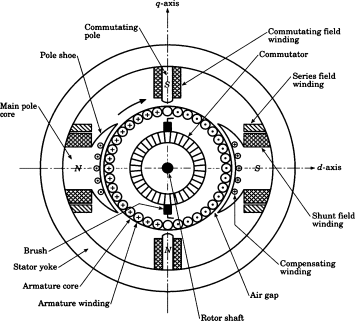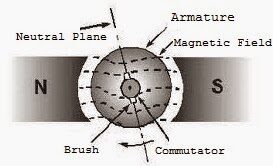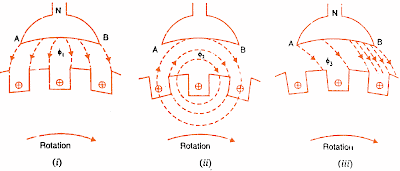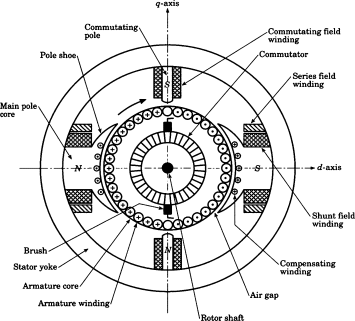
Like a DC generator, a DC motor experiences armature reaction as current flows through its armature conductors, creating an armature flux that interacts with the change in the main poles. The resulting polarity and direction of rotation are the same as those of the generator, but the direction of the armature field is reversed.
In this article we examine the effects of armature reaction on a DC motor and its consequences. Furthermore, we study how various components such as gears, clutches, transformers, resistors, capacitors, inductors, switches, diodes, transistors, amplifiers and feedback systems can optimize motor performance for different applications.”

Relationship between armature current and back emf
Armature current
Armature current refers to the current that flows through the armature winding of a DC motor or generator. In motors, this is the current that drives mechanical rotation, while in generators it is the output current produced by the automatic process.
Counter Electromotive Force (EMF)
Reverse electromotive force, often referred to as back emf or back emf, is the voltage induced in the armature windings due to the relative motion between the conductors and the magnetic field. In motors, back EMF opposes the applied voltage and limits the armature current, while in generators it is different from the change in magnetic flux and affects the voltage produced.
Meaning of armature current and reverse emf
The connection between armature current and back EMF is crucial for several reasons:
-
- Engine power and torque
- Generator power and control
- Engine/generator protection
Engine Performance and Torque
In a DC motor, the back EMF is proportional to the motor speed. As the motor accelerates, the back emf increases, reducing the net voltage across the armature and consequently limiting the armature current. This relationship is critical for controlling engine speed and torque.
Generator power and control
In a DC generator, the back EMF determines the output voltage. As the armature current increases, the voltage drop across the armature resistance increases, causing the net or output voltage to decrease. Understanding the relationship between armature current and back-EMF allows efficient voltage control in DC generators.
Engine/generator protection
The relationship between armature current and back EMF protects the motor or generator from excessive current flow. The back EMF neutralizes the applied voltage and limits the armature current to a safe range. Monitoring this relationship helps prevent damage to the motor/generator due to overload.
Contrasting armature response in motors and generators

In a DC generator, the armature reaction increases the flux at the test leads and attenuates the shift at the front pole tips, while in a DC motor, the armature reaction produces the opposite effect.
A DC generator cannot use commutation poles and brushes like the GNA; For sensible switching, the polar points must be moved in the direction of rotation. In a DC motor, however, the brushes are moved in the opposite direction to the direction of rotation.
If no commutation poles are used, the brushes are given a reverse direction in a DC motor and a forward direction in a DC generator.
By using switching poles, the DC machine operates with fixed brush positions for all load conditions. Meanwhile, the switching pole windings transfer armature current whenever a device switches from the generator to the motor. The polarities of the switching poles must have opposite signs.
This is why the commutation poles in a DC motor must have the same polarity, because the main rods are directly behind them. This is often the opposite of the corresponding polarity on a DC generator.
Conclusion
An important finding is the opposite orientation of armature flux in DC motors compared to generators. While the armature current in motors flows against the back EMF, creating instability that is distorted in the opposite direction to rotation, generators have a flux distortion consistent with the process. This fundamental difference highlights the importance of understanding the unique behavior of armature reactions in engines.
Common questions
What are magnetic flux and flux density in electrical machines?
Magnetic flux refers to the total magnetic field that flows through a given surface. It is measured in Weber (Wb). Flux density, on the other hand, represents the amount of magnetic flux per unit area and is measured in Tesla (T).
What is the influence of alternating pole windings on the performance of DC machines?
Interpoles are additional magnetic poles placed between the main field poles of a DC machine. They are used to neutralize armature feedback, reduce switching problems and improve the process, thereby increasing the overall performance of the machine.
How important is the MNA (Modified Nodal Analysis) method in the analysis of electrical machines?
The MNA method is often used in the analysis and simulation of electrical machines. It simplifies complex circuits with interconnected components, such as: B. electrical machines, into nodal equations and thus facilitates the calculation and investigation of the system's behavior.
How does saturation affect a generator's performance?
Saturation refers to the point at which the magnetic material in the generator core reaches its limits and can no longer transmit additional magnetic flux. This can lead to increased losses and reduced generator efficiency, affecting its overall performance under high loads.
What is the purpose of the N-pole reversal method in magnetic flux control?
The N-pole reversal method is used in some electrical machines to effectively control the magnetic field and flow direction. By reversing the magnetic poles at specific intervals, it is possible to improve the efficiency and performance of the machine in certain applications.

